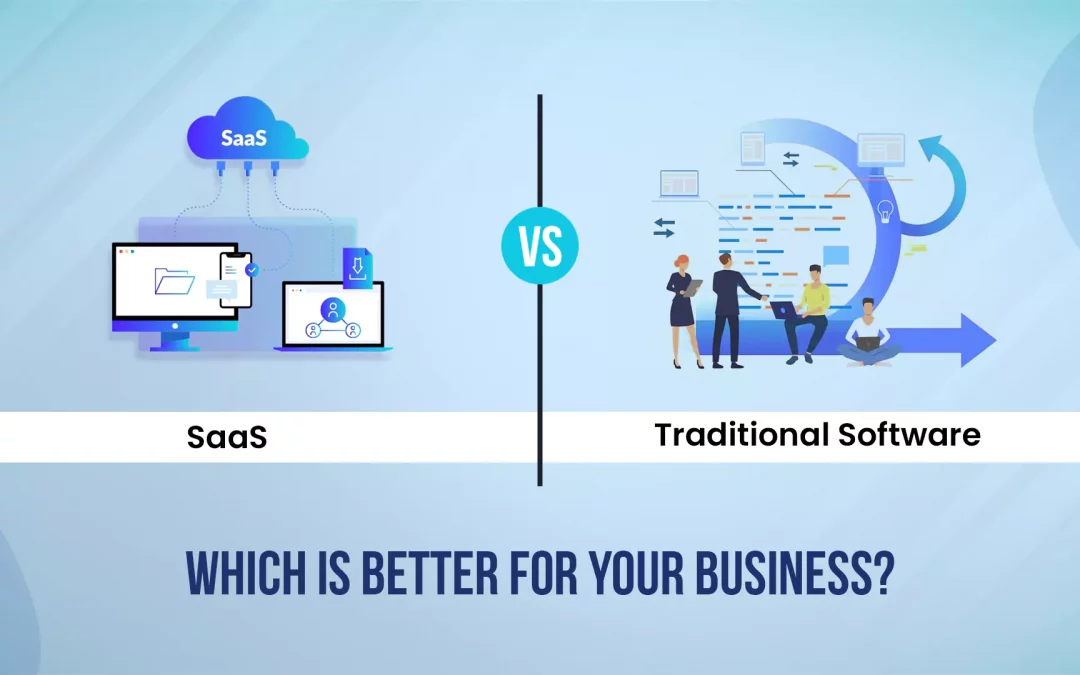Technology adoption is vital to succeeding in today’s highly competitive digital landscape. Businesses across diverse sectors keep searching for innovative ways to meet their web hosting needs. The best option so far is cloud computing, which helps organizations carry out their routine tasks and satisfy their consumers.
When it comes to cloud computing, businesses have two choices: Software as a Service (SaaS) and traditional software. Both these options have their own strengths and limitations. SaaS is a subscription-based model that offers extended flexibility and scalability. On the other hand, traditional software is installed on-premises and ensures better control over confidential data.
If you are looking for viable software for your business, check out the below comparison between SaaS and traditional software.
Let’s get started!
What is Software as a Service (SaaS)?
Software as a Service (SaaS) is a subscription-based software delivery model that allows users to access their desired applications online via the internet. SaaS applications are hosted by third-party cloud vendors who are responsible for the maintenance of servers, databases, and infrastructure.
The primary advantage of SaaS over traditional software is that they don’t need on-premises installation. Besides, multiple users at different locations can access SaaS applications online without purchasing an expensive software license. Since SaaS solutions follow the pay-as-you-go model, companies can acquire their desired features on an as-needed basis.
These qualities make Saas applications a viable option for startups and individuals who cannot afford to buy expensive traditional software. Moreover, it SaaS also offers additional benefits like ease of use, universal access, and scalability.
Pros of Software as a Service (SaaS)
- Faster deployment and delivery
- Reduced time to market
- Universal accessibility
- Extended integration options
- Scalability
- User-friendly and easy to use
- Regular updates and new product releases
- Small upfront costs
- Minimal risk of system failure
- Cross-functional compatibility
Cons of Software as a Service (SaaS)
- Limited or no control over databases
- Higher security risks
- Limited customization options
- Contractual obligations
- Loss of application control
- Compliance issues
- Troublesome software integration
- Requires internet to access full features
- Risk of service termination
- Cumbersome data mobility
What is Traditional Software?
Traditional software is opposite to Software as a Service. Unlike SaaS applications that are hosted on cloud servers, traditional software is installed on the client’s premises. Consequently, you are the sole owner of your software installed via the hosting center.
On-premises software installation requires a costly upfront payment for traditional software. Hence, this option is feasible only for well-established or large organizations that have sufficient resources. Nevertheless, you can customize these applications as per your business needs without relying on third-party cloud vendors.
Moreover, you can easily update or scale the traditional software to meet ever-changing business needs. It also offers better data security since your database is safe and secure. Hence, you can enjoy exclusive benefits like extended control over company data and more customization options.
Pros of Traditional Software
- Data security with regular backups
- A range of customization options
- Better control over database and functions
- Optimization of consumer satisfaction
- Secure and flexible
- Adaptability
- Doesn’t involve third-party cloud servers
- Offline accessibility
- Clear purpose and optimization
- More sequential and robust
Cons of Traditional Software
- Requires additional installation and support for integration
- Higher upfront costs
- Requires advanced technical skills and expertise
- An expensive option requires sufficient resources for better results
- Needs round-the-clock management and strict monitoring
- Slower development process
- Time-consuming
- Little room for innovation
- Limited flexibility
- Not affordable for startups or SMEs
Which One to Choose?
Both SaaS and traditional software drive workplace productivity and contribute to organizational growth and development. However, when it comes to choosing one option, companies need to consider their needs first.
Software as a Service (SaaS) is a cost-effective option with limited customizable options. Hence, established SMEs should prefer SaaS applications to access their desired features while keeping their budgets in control. Moreover, SaaS solutions are hosted on cloud servers and can be accessed anytime, anywhere. Therefore, businesses following remote or hybrid work environments can use these software systems for workforce automation and project management.
Traditional software, on the other hand, is an expensive option that requires high upfront costs and advanced technical expertise. Hence, only those companies can afford traditional software that has sufficient resources to host, manage, maintain, and upgrade these systems without external support. Nevertheless, traditional software is more resilient and offers more customization options. Therefore, companies can deploy these applications to stay ahead of their competitors and achieve long-term sustainability.
Final Words
Software as a Service (SaaS) and Traditional Software are two popular options for operational management. SaaS is a subscription-based model that allows users to access their desired functionalities anytime, anywhere through the internet. On the other hand, traditional software requires on-premises installation and ensures better control over the database and higher data security.
Based on the above comparison of these two models, it can be concluded that SaaS is the future. SaaS applications have evolved over the years through innovation and continuous improvement. Today, SaaS is one of the widely adopted software delivery models across the globe. Besides, companies from all sectors and sizes are moving towards SaaS to automate their operations and achieve higher growth.
If you are also looking for a trusted and reliable SaaS partner, get in touch with Khired Networks. As a leading provider of custom SaaS applications, we help businesses become more resilient and productive by leveraging cutting-edge technologies.
Talk to our experts today and start uplifting your business to new horizons.

